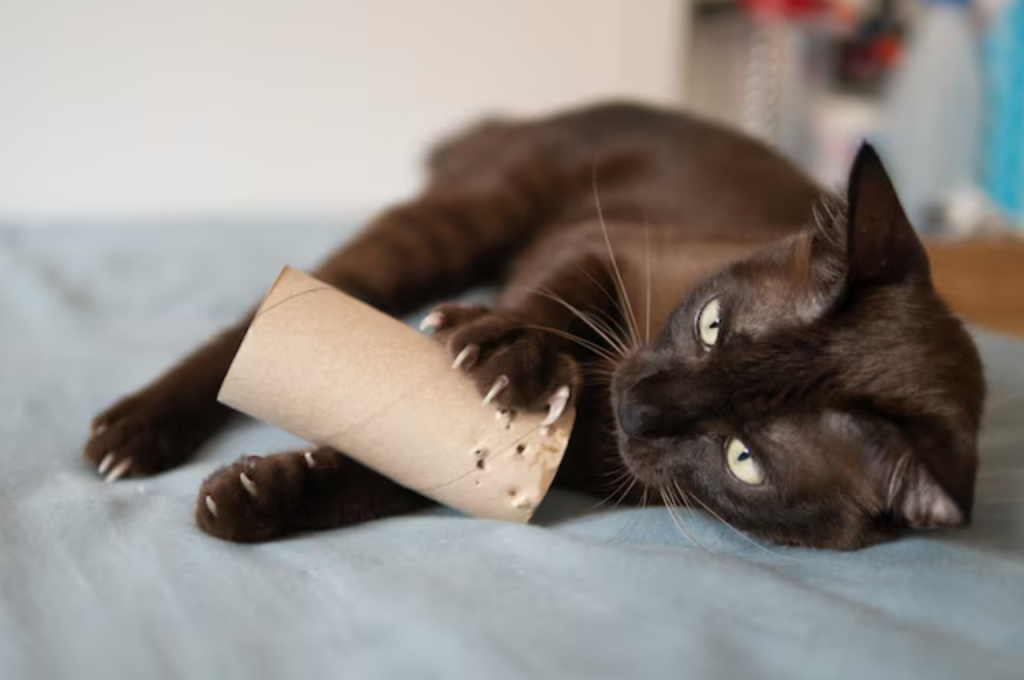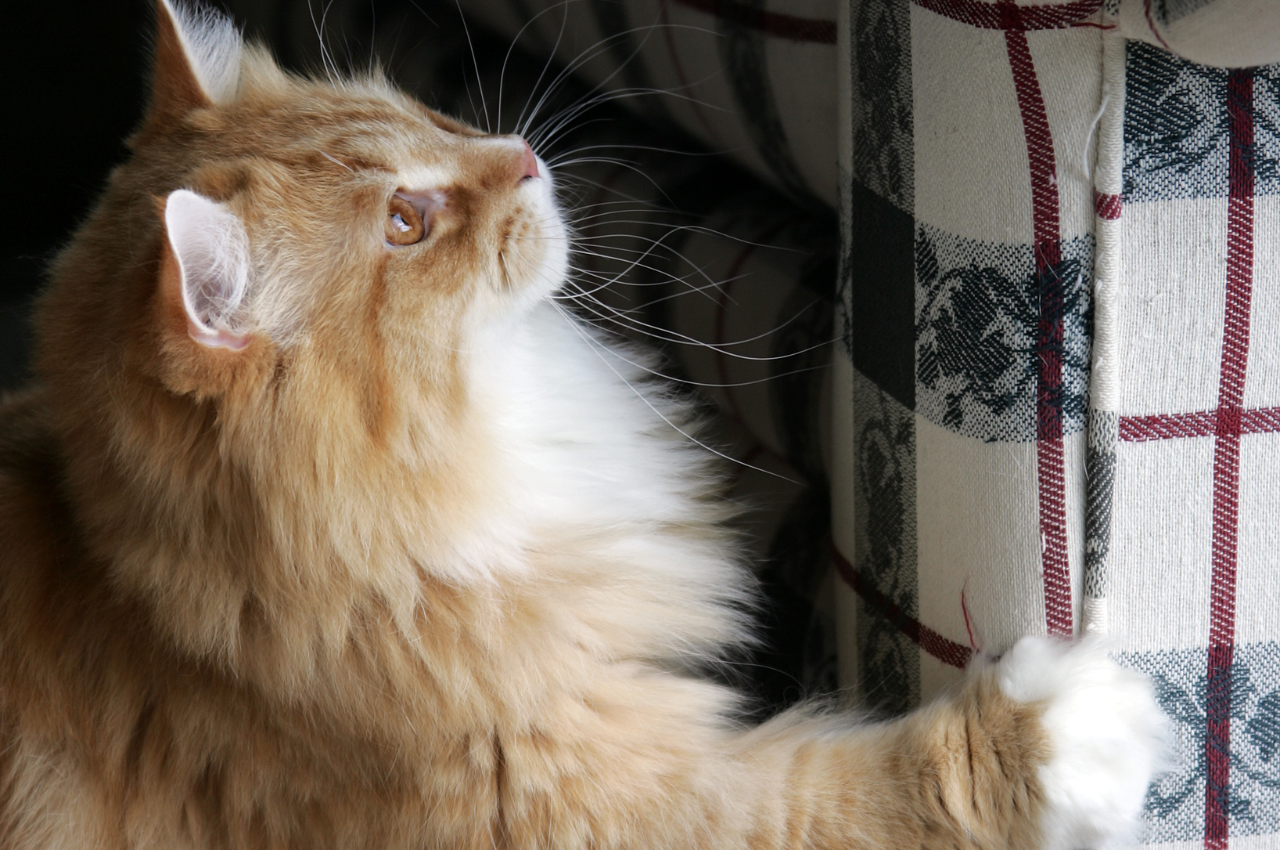To train cats not to scratch furniture, provide scratching posts, redirect their behavior, use deterrents, and reward good behavior. Cats can be trained not to scratch furniture by offering appropriate scratching alternatives, such as scratching posts.
Redirecting their behavior towards the designated scratching area and using deterrents like double-sided tape or citrus scents on furniture can help discourage unwanted scratching. Additionally, rewarding cats with treats or praise when they use the scratching posts can reinforce positive behavior. Training cats to avoid scratching furniture requires patience and consistency, but with the right approach, it can be successful in protecting your furniture while keeping your feline friend happy.
Introduction to Feline Scratching Habits
Cats are known for their natural instinct to scratch, which is a behavior deeply rooted in their primal instincts. Understanding the reasons behind this behavior is crucial in effectively training cats to avoid scratching furniture. In this blog post, we will explore the underlying reasons why cats scratch and the impact it can have on household furniture. By gaining insights into feline scratching habits, you can implement targeted strategies to redirect this behavior and preserve your furniture.

Why Do Cats Scratch
Cats scratch for various reasons, including maintaining their claws, stretching their muscles, and marking their territory. This innate behavior is a vital aspect of their physical and psychological well-being. Understanding the motivations behind scratching can help cat owners effectively address and redirect this behavior.
The Impact on Household Furniture
Feline scratching can have a significant impact on household furniture, leading to unsightly damage and costly repairs. The shredding of upholstery and wooden surfaces can diminish the aesthetic appeal of furniture, making it essential to address this behavior proactively. By acknowledging the potential consequences of scratching, cat owners can take proactive measures to protect their furniture.
Identifying Your Cat’s Scratching Preferences
Cats have natural scratching behaviors, and identifying their scratching preferences is crucial in training them to avoid furniture damage. By observing their scratching patterns and understanding the surfaces and textures they prefer, you can effectively redirect their behavior to appropriate scratching posts and pads.
Observing Scratching Patterns
Observe when and where your cat tends to scratch. Look for cues like after waking up or before mealtime. Note the locations and angles at which they scratch to determine their preferences.
Common Surfaces and Textures Cats Prefer
Cats often prefer specific surfaces and textures for scratching. These may include rough textures like sisal, smooth surfaces such as wood, or vertical structures like cardboard. Identifying these preferences can guide your choice of suitable scratching posts and materials.
Essential Supplies for Redirecting Scratching
When training your cat not to scratch furniture, having the essential supplies for redirecting scratching is crucial. By providing the right tools, you can encourage your cat to fulfill their scratching instincts in appropriate ways. Here are the key supplies you’ll need to successfully redirect your cat’s scratching behavior.
Types of Scratching Posts
- Vertical Posts: These are essential for cats who prefer to stretch upward while scratching. Look for sturdy posts that are tall enough for your cat to fully extend their body.
- Horizontal Posts: Cats that enjoy scratching carpets or rugs will benefit from horizontal scratching posts. These can be simple flat pads or more elaborate structures.
Alternatives to Traditional Scratching Posts
- Scratching Pads: These are often made of cardboard and provide a satisfying texture for cats to scratch. They can be placed on the floor or mounted on walls.
- Sisal Fabric: Using sisal fabric to cover existing furniture or creating DIY scratching surfaces can provide an alternative scratching outlet for your cat.
Training Techniques to Discourage Furniture Scratching
Train cats not to scratch furniture by providing scratching posts, using deterrents like double-sided tape or citrus scents, and rewarding good behavior with treats. Consistency and patience are key in redirecting their natural scratching instincts.
Cats love to scratch, and it’s a natural behavior for them. However, their scratching can cause severe damage to your furniture, which can be frustrating for any cat owner. While it may seem impossible to stop your cat from scratching your furniture, there are several training techniques that can help you discourage this behavior. In this post, we’ll explore some effective methods to train your cat not to scratch your furniture.
Positive Reinforcement Strategies
Positive reinforcement is one of the most effective methods for training cats. It involves rewarding your cat for good behavior, such as using a scratching post instead of your furniture. Here are some positive reinforcement strategies you can use to discourage furniture scratching:
- Offer treats and praise when your cat uses a scratching post
- Use a clicker to signal when your cat does something good, followed by a treat
- Provide your cat with toys and playtime to keep them active and distracted from scratching furniture
Effective Use of Deterrents
Deterrents can be an effective way to discourage your cat from scratching furniture. These are methods that make the furniture unattractive or uncomfortable for your cat to scratch. Here are some effective deterrents you can use:
| Deterrent | Description |
| Double-sided tape | Place double-sided tape on the furniture to make it uncomfortable for your cat to scratch |
| Scratch repellent spray | Spray scratch repellent on the furniture to make it unattractive to your cat |
| Cover furniture | Cover your furniture with a blanket or a sheet to protect it from scratches |
By using these positive reinforcement strategies and deterrents, you can train your cat not to scratch your furniture. Keep in mind that training takes time and patience, so be consistent with your training methods, and don’t give up. With a little effort, you can have a happy cat and an intact furniture collection.
Creating an Appealing Scratching Environment
Cats need a designated area to scratch to satisfy their natural instincts. By creating an appealing scratching environment, you can redirect their behavior away from furniture.

Placement of Scratching Posts
- Position scratching posts near the areas where your cat likes to scratch.
- Place posts in prominent locations with good visibility and accessibility.
- Ensure stability by securing posts firmly in place.
Encouraging Use of Catnip and Toys
- Introduce catnip to attract your cat to the scratching posts.
- Offer interactive toys to engage your cat in scratching activities.
- Rotate toys regularly to keep your cat interested and entertained.
Regular Nail Care for Your Cat
Regular nail care for your cat is essential to prevent it from scratching furniture. Train your cat to use a scratching post by placing it near their favorite spot, rewarding them when they use it, and using deterrents like double-sided tape on furniture. With patience and consistency, your cat can learn to scratch appropriate surfaces. Cats have a natural instinct to scratch, but you can train them not to damage your furniture by taking care of their nails regularly.
The Importance of Trimming
Regular nail care for your cat is crucial for their comfort and health. Trimming your cat’s nails helps prevent them from becoming too long or sharp, which can lead to painful breaks, splits, or even ingrown nails. Keeping their nails at an appropriate length also reduces the risk of damage to furniture, carpets, or accidental scratches to people. Regular trimming promotes better hygiene and can prevent the buildup of dirt and debris around the claws, which could otherwise lead to infections. It also helps your cat feel more comfortable while walking and prevents them from getting caught on fabrics or other surfaces.
Making nail trimming a routine part of your cat’s care ensures they stay healthy, happy, and stress-free.
Safe Nail Trimming Techniques
Use proper techniques and tools to trim your cat’s nails without causing harm.
- Hold your cat firmly but gently
- Use specialized cat nail clippers
- Trim only the sharp tip of the nail
- Reward your cat with treats after trimming
Regular nail care is crucial for training your cat not to scratch furniture.
Behavioral Correction and Consistency
Behavioral correction and consistency are the key components of training cats not to scratch furniture. With patience and persistence, you can teach your furry friend how to use a scratching post instead of damaging your furniture.
Responding to Undesirable Scratching
When you catch your cat scratching furniture, it’s important to respond in a calm and controlled manner. Don’t shout or hit your cat. Instead, use a firm tone and redirect your cat’s attention to a scratching post. You can also use deterrents such as double-sided tape or aluminum foil to discourage your cat from scratching in unwanted areas.
Maintaining Consistent Training
Consistency is key when training your cat not to scratch furniture. Make sure your cat has access to a scratching post at all times and place it in an area where your cat likes to scratch. Reward your cat when they use the post correctly and be patient if they continue to scratch furniture. With time and effort, your cat will learn that scratching the post is more rewarding than scratching furniture.
Monitoring Progress and Making Adjustments
To train cats not to scratch furniture, monitor their progress, and make adjustments as needed. Use positive reinforcement, such as treats and praise, when they use appropriate scratching posts. Redirect their behavior when they scratch furniture and be consistent in your training approach.
Assessing The Effectiveness of Strategies
After implementing the various strategies to train your cat not to scratch furniture, it is important to monitor their progress and make adjustments as necessary. You should assess the effectiveness of each strategy to determine which ones are working and which ones need to be modified or replaced. One way to assess the effectiveness of the strategies is to keep a log of your cat’s behavior and note any changes over time. If you notice that your cat is scratching less or not at all, then the strategy is likely working. If you see no improvement or your cat is still scratching furniture, it may be time to try a different approach.
When to Seek Professional Help
While most cats can be trained not to scratch furniture with patience and consistency, some cats may require professional help. If you have tried several strategies and your cat is still scratching furniture, it may be time to seek the advice of a professional animal behaviorist or veterinarian. A professional can help you assess your cat’s behavior, identify the underlying cause of the scratching, and develop a customized training plan. They can also provide guidance and support throughout the training process to help ensure success.
Remember, training your cat not to scratch furniture takes time and patience, but with the right strategies and adjustments, you can help your cat develop good scratching habits and protect your furniture.
Fostering a Scratch-friendly Home
Create a scratch-friendly environment for your feline friend by providing suitable scratching posts and deterrents. Redirect your cat’s scratching behavior with positive reinforcement and regular nail trimming. Invest in scratching pads and toys to keep your pet engaged and prevent furniture damage.

Balancing Your Cat’s Needs with Home Preservation
Cats need to scratch to maintain their claws. Provide appropriate scratching posts in various locations. Train your cat to use the designated scratching posts.
Celebrating Small Victories in Training
Praise your cat when they use the scratching post. Reward good behavior with treats or playtime. Be patient and consistent in your training efforts.
Conclusion
Training cats not to scratch furniture can be a challenging task, but with patience, consistency, and the right techniques, it is definitely achievable. By providing suitable alternatives, using positive reinforcement, and implementing deterrents, you can redirect your cat’s behavior and protect your furniture.
Remember to be gentle and understanding throughout the process, as cats respond best to positive reinforcement. With time and effort, you can create a harmonious environment where your cat and furniture coexist peacefully.
